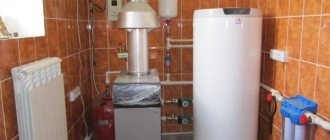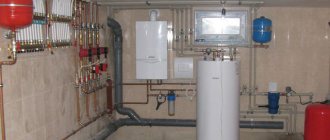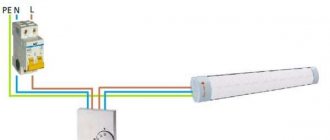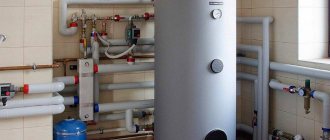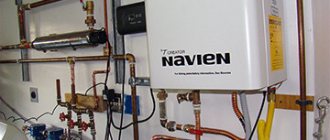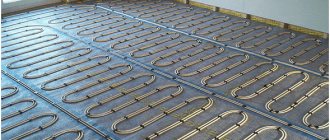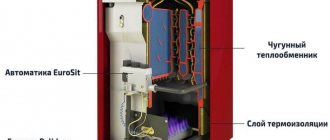Gas boiler maintenance must be done regularly. During the annual inspection, failures in the operation of automation, the safety of insulating materials, and the tightness of components and pipes are identified. This ensures the safety of the equipment and achieves savings by fine-tuning the gas flow. In this material we will talk about the actions that need to be performed for proper prevention of a gas boiler. Let's look at the example of a wall model. Most often, it is wall-mounted boilers that require detailed maintenance. The following maintenance steps can be defined:
- shutdown of gas, water and electricity
- coolant drain
- turbine maintenance
- cleaning the heat exchanger
- cleaning gas burners and electrodes
- boiler cleaning
- checking the expansion tank
- checking flow sensors and filters
- gas pressure adjustment
- connection and testing
Turbine maintenance
Gas boiler turbine
The exhaust fan ensures proper removal of carbon dioxide, soot and smoke after combustion of the gas mixture. After dismantling the fan, it is worth checking the chimney pipe leading to the street for clogging. The fan must be cleaned of dust and the shafts lubricated. The condensate collector leading to the turbine must be sealed.
Guarantees
We provide a guarantee on behalf of our company for all work performed on boiler maintenance or repair. The warranty applies to absolutely all equipment and is valid from 14 days to 1 year, depending on the brand and complexity of the work.
This guarantee is confirmed by an official certificate of work performed, signed by both the master and the owner of the equipment. All data is entered into the CRM database and has a storage period of 5 years.
In case of replacement of faulty components or assemblies, we use only original spare parts, which are also subject to warranty.
Permitting documentation of our company
In accordance with the legislation of the Russian Federation, we have the right to carry out maintenance of gas equipment. This permit is supported by a License for hazardous gas work, a SRO Certificate, an Agreement with Mosoblgaz, and an Agreement with the housing inspectorate. Each employee of our company is certified, was trained at a training center and received a standard certificate with the right to perform gas-hazardous work.
Order service
Cleaning the gas burner chamber and heat exchanger
gas boiler burner
After removing the cover, clean the outer fins of the heat exchanger from combustion products with a coarse brush. A well-cleaned heat exchanger ensures uniform heating of water or other coolant and prevents local overheating.
Using a soft copper brush, you need to remove any remaining soot from the ignition electrodes and ionization sensor, which are located in the chamber, and wipe them with isopropyl alcohol. Finally, you need to check the gap from the electrode to the burner, which should be about 4 mm.
Basic steps of the current service
To fully control the situation, you should understand what work is performed when servicing various parts and components. Routine maintenance of a boiler generator includes three main types of work: cleaning, checking and adjustment.
Before servicing gas equipment, it is mandatory to turn off the system and gas supplies. The disconnected system should cool down slightly.
Step #1 - inspection of heating circuits
At this stage, a general idea of the current state of the operating system is formed.
First of all, the technician checks the documents and the warranty seal, determining whether the installation of the gas appliance meets the requirements of two main regulatory documents:
- SNiP - sanitary building codes and regulations.
- “Rules of technical operation and safety requirements in the gas industry of the Russian Federation.”
Since a gas boiler is a set of equipment that uses both gas and electricity, electrical elements are also subject to visual testing.
For an external inspection of a gas boiler, the protective casing is removed from the unit and all visible elements are sequentially inspected, identifying the degree of wear of parts
Checking the condition of the boiler unit is intended to clarify the following points:
- integrity of the device structure;
- gas valve pressure;
- ignition electrodes, if available;
- condition of gas supply connections;
- electronics performance;
- serviceability of emergency machines.
At this stage, the expansion tank is monitored and pumped, which is designed to protect the system elements and compensate for the pressure that is created during the expansion of the coolant.
During the technical inspection, the condition of the unit itself, protection devices and gas communications is visually and using instruments.
The pressure level in cold water, depending on the type of boiler, is 1.1-1.3 bar. It is important to ensure that after heating the pressure does not exceed the recommended standard specified in the passport for the unit.
Step #2 - cleaning system elements
Before starting work, empty the boiler. After this, they begin to inspect the gas burner, determine the quality and direction of the flame.
To do this, remove and clean sequentially:
- retaining washer - a device that regulates the position of the burner torch relative to the installed heat exchanger;
- air sensor - it is designed to regulate the ratio of the mixture of air and gas;
- flame detector sensor - it generates a signal when traction indicators deteriorate;
- ignition device electrode – responsible for igniting gas-air mixtures;
All metal structures can become deformed over time under the influence of high temperatures and carbon deposits.
To prevent scale from clogging the burner, which is a key working element of the boiler, it must be cleaned in a timely manner using special brushes.
During normal operation of the burner, the flame has the shape of a cone, colored blue. A yellowish color indicates contamination.
Measuring and analyzing the boiler exhaust gases will help check the operation of the key operating element of the boiler and assess the compliance of the burner settings with the composition of the supplied gas, as well as the completeness of its combustion.
The fire area on the fuel combustion chamber and all parts of the boiler that are in direct contact with the torch must be cleaned. This task can be easily accomplished using a soft brush and a vacuum cleaner.
When cleaning injectors, do not use a metal brush, the bristles of which can damage the surface.
Separately, unscrew and blow air through the gas channels of the boiler. The gas supply pipe to the burner is removed, disassembled and purged under pressure.
The heating system is equipped with two filter elements. The first is located in the hydraulic unit, and the second is located on the cold water tap. These filters also require periodic cleaning of salt deposits by washing.
As maintenance is carried out, all faults discovered by the technician must be eliminated, replacing failed parts and assemblies with new elements.
Step #3 - checking the control automation
Modern boilers are equipped with automatic control systems, the main purpose of which is to ensure the operation of the unit without constant human supervision. The degree of complexity of automation can be very different.
But regardless of the model, its main elements are:
- Thermostat is a regulating device responsible for maintaining the set temperature parameters of the coolant in the boiler.
- Gas valves are designed to open and shut off the gas supply.
- Gas fittings are an actuator designed to execute commands from the boiler control circuit.
- The controller is an electronic device designed to implement a complex algorithm for controlling the unit depending on changing environmental conditions.
- Minimum and maximum pressure switches are membranes that act on groups of contacts, turning off the unit if the pressure drops/increases below/above the setting value.
This technique “painfully” endures a regular drop in tension. The technician’s task is to promptly detect problems in the electronic system, possible problems with parts, and correctly adjust the automation.
The boiler connected to the gas boiler, which is designed to supply the DHW system, must also be checked annually and regularly adjusted.
To check the functionality of the boiler safety system and identify vulnerable areas of the equipment, the technician simulates the occurrence of an emergency situation. After starting the system, he monitors the speed of operation of the alarms, the tightness of the shut-off valve and other devices.
If the automation does not work correctly, the unit is disassembled and the failed membranes are replaced with new ones.
The inlet part of the gas pipe is also subject to inspection. It is examined for corrosion and other damage.
The master must ensure the integrity of the gas supply pipeline throughout the entire section laid in the house, paying special attention to the outer surface of the pipes and their connections
All connections of the gas path, including flanged, threaded and prefabricated, are tested for leaks. Measure the pressure in the gas pipeline. If necessary, adjust the gas fittings. Places where paint has peeled off from the surface of the pipe are repainted.
Having adjusted all components of the boiler unit, the technician sets the parameters recommended by the manufacturer.
At the final stage, it carries out a final inspection of the boiler. The master fills out certification documents, confirming with his signature personal responsibility for the quality of the inspection performed. Finally, he makes a note indicating the period for the next service.
Chemical descaling
gas boiler heat exchanger
There are operating conditions (they are indicated at the end of the article) under which it may be necessary to service a gas boiler in the form of cleaning the heat exchanger from scale. In this case, the supply pipes are unscrewed and the entire heat exchanger is dismantled. For chemical cleaning, it must be filled with a solution of hydrochloric acid, which dissolves blockages. After 10-15 minutes, drain and rinse with running water. If during washing there are still difficulties with the passage of water, the cleaning process should be repeated.
What do the manufacturers say?
Some manufacturers recommend maintenance, others say nothing about it.
Will the boiler be removed from warranty if a service company gets into it?
If the service is carried out by specialists, the warranty will not be removed - according to the law. Moreover, some manufacturers may increase its duration if you carry out maintenance in a timely manner. Information about this is contained in the warranty card, please read it carefully.
I want to install a new boiler in my house - which one should I choose?
Adjusting the pressure of the expansion tank
During the production of a gas boiler, nitrogen is pumped into the expansion tank, but during operation, manufacturers are allowed to pump it with ordinary air. An expansion tank is necessary to compensate for excess pressure that occurs as a result of heating and cooling of the coolant. In addition, it has the function of protecting against water hammer in the heating system.
To completely prevent a gas boiler, you need to measure the pressure in the expansion tank using a pressure gauge. For most wall-mounted boilers, the pressure required for operation is 1 bar. The exact numbers need to be clarified in the documentation for the boiler. In the event that the pressure is insufficient, it is necessary to pump nitrogen or atmospheric air into it using a compressor. In case of excess pressure, it is necessary to bleed off the excess through the valve.
What is included in the list of services
A set of maintenance works for wall-mounted gas boilers.
The list of work carried out by the service depends on the type of boiler room and is regulated by the boiler manufacturer’s instructions.
The list includes:
- equipment inspection;
- installation of the input panel;
- checking the expansion tank;
- identifying the operability of safety devices;
- control of power supply, exhaust and supply ventilation, as well as the chimney;
- replacing filter cartridges and injectors;
- cleaning of mud filtration elements;
- study of the functioning of servos, valves and circulation pumps.
The technician checks the external and internal state of the device, the automation settings and the burner operation algorithm.
Cleaning filters
Incoming filtering is necessary. If water is used as a coolant, the flow often contains fine sand, silt, scale, rust or metal shavings. Dirt entering the system can disrupt the operation of the input flow sensor, clog the heat exchanger, etc.
The filter and flow sensor are cleaned using ordinary running water and a brush with hard bristles. Next, before reinstallation, to soften the O-rings that prevent leakage, they need to be treated with silicone grease to achieve a tight connection.
Prices
Depending on the type of boiler, its power and placement option, we have a current price list for boiler maintenance. The cost of the work is publicly available and does not include hidden prices, which are sometimes used by unscrupulous companies or private craftsmen.
We try to maintain the minimum acceptable cost of work so that each of our clients can afford boiler maintenance and ensure a long service life of the heating equipment.
Undoubtedly, we are committed to long-term cooperation and when concluding a boiler service agreement with our company, we will be able to offer special conditions and more flexible prices for subsequent repairs, calling a technician and carrying out routine maintenance. You can obtain more accurate information from our engineer by phone or mail indicated in the CONTACTS section.
| Service | Price |
| Maintenance of atmospheric boiler with power up to 30 kW | from 4,500 rub. |
| Maintenance of atmospheric boiler with power from 30 to 60 kW | from 7,500 rub. |
| Maintenance of atmospheric boiler with power from 60 to 110 kW | from 10,500 rub. |
| Maintenance of turbocharged boiler up to 30 kW | from 5,500 rub. |
| Maintenance of turbocharged boiler with power from 30 to 60 kW | from 8,500 rub. |
| Maintenance of turbocharged boiler with power from 60 to 110 kW | from 11,500 rub. |
Maintenance contract cost
Gas pressure adjustment
Measuring and adjusting the minimum and maximum gas pressure will not only achieve proper operation of the boiler, but also save money. The exact pressure range is indicated in the instructions. For wall-mounted boilers it is at least 2 mbar. The maximum pressure is 13 minibar.
If there are no errors, start the gas boiler and open the gas valve. Using a differential pressure gauge, we measure the minimum gas pressure in the system. To measure the maximum possible pressure, turn on the boiler in the “chimney sweep” mode and check the pressure in this mode. If necessary, adjust the pressure to the specified values.
Professional solution to the issue
At first glance, there is nothing complicated in carrying out preventive maintenance measures for boiler units. But you shouldn’t set up and clean a gas boiler yourself. And it's not just a matter of experience.
Such a critical procedure should only be performed by a qualified specialist who has the precise equipment necessary to diagnose faults.
The quality of boiler equipment maintenance directly depends on the professionalism of the technician. Therefore, such work should be entrusted only to professionals with special permission.
In the event of an unforeseen situation, the master will be able to react correctly and quickly, thereby preventing unjustifiably serious, sometimes catastrophic consequences
According to paragraph 6.2 of the current SNiP, servicing of boiler equipment must be carried out by licensed organizations that have their own emergency dispatch service.
Leading manufacturers of gas boilers, in order not to open branded service centers in every region of the country, issue licenses to organizations specializing in the field of maintenance.
You may be interested in information on how to choose a good and reliable gas boiler, discussed in our other article.
In addition to a certificate for performing a specified range of work, such organizations receive full access to technical documentation for equipment produced by the manufacturer, as well as the opportunity to receive new boiler components for warranty replacement. A list of certified companies is usually listed on the manufacturer's website.
When choosing a service organization and drawing up a contract, you should focus on two parameters:
- Certification of the boiler manufacturer, confirmed by the presence of a license to carry out work.
- The location of the service center in the same city or region, which will reduce the response time of the field technician.
In most cases, a service contract is signed before the boiler is fully put into operation. It clearly states the list of future works and the deadlines for their completion.
As a supplement to the contract, a boiler passport is attached, which specifies all the design features of the system, a complete list of its components and elements, as well as the timing of maintenance.
The work offered by service organizations is divided into three types:
- Routine maintenance is regular preventative work carried out to assess the technical condition of the unit, identify and eliminate impending breakdowns, to prepare the unit for the heating season and after its completion before summer inactivity.
- Maintenance upon request of the subscriber - includes measures to identify violations and damage to the system, diagnose the performance of the gas appliance or its individual parts, and eliminate breakdowns and malfunctions.
- Overhaul is a set of measures in the event of a unit breakdown, carried out in the event of emergency situations caused by external factors or as a result of equipment failure.
The regularity of preventive maintenance of equipment depends on the purpose of the installed unit and its design.
A list of mandatory “procedures” for routine maintenance and overhaul, as well as the frequency of their execution, is provided by the manufacturer for each specific model
On average, routine inspections are recommended to be performed 2 times a year. They are carried out both for devices included in the heating circuit and for units of hot water supply systems.
Failure to meet the deadlines for such an important event can lead to serious consequences. Thus, a clogged pipeline can cause a failure of the heating system, and depressurization of a gas pipeline can cause an explosion and fire.
Image gallery
Photo from
Stage 1: General diagnostics of the technical condition of the equipment
Stage 2: Adjusting the column ignition and gas combustion process
Step 3: Checking the tightness of the heat exchanger
Stage 4: Monitoring the condition and performance of the turbine
The importance of correct gas pressure setting
When the pressure drops below acceptable values, the boiler automation is not able to accurately regulate the heating temperature and operates at maximum values. The electronics opens the maximum pressure and heats the boiler to the required temperature, but due to insufficient pressure, it is impossible to maintain the desired temperature. The automation shuts off the gas and, after reaching the minimum allowed temperature, again heats the boiler to the maximum in the maximum possible mode.
If the gas pressure exceeds the rated values, the flame height is too high. This can lead to premature burnout of the heat exchanger, which is not designed to operate in this mode.
Compare this with normal operating mode, in which the temperature is gradually brought to the required values, and then maintained at a minimum gas flow. In this case, gas consumption decreases due to the smooth dynamics of heating and cooling.
Equipment maintenance in emergency conditions
If an emergency occurs, the problem must be responded to quickly. In most cases, breakdowns occur due to continuous use at maximum power level or low-quality fuel entering the system.
If there is a service agreement, then you need to contact the organization, fill out an application, after which a technician will come and fix the breakdown. The specialist has a set of tools and parts that correspond to the model, since the service center keeps records of gas and diesel boilers.
Sometimes they may not arrive immediately upon request. It is not recommended to use the services of private masters. In order not to encounter poor-quality repairs, you need to use the service of a special company before winter.
Is it necessary to chemically clean the inside of the heat exchanger?
Under normal operating conditions, no. The service life of the heat exchanger is about 6-7 years and after this time it is easier to make a preventive replacement. Annual dismantling and reinstallation will only increase the risks associated with possible destruction of connections and the risk of subsequent fluid leakage.
However, there are reasons why annual chemical cleaning may be worthwhile. This is very hard water that contains too many mineral impurities. A layer of scale builds up too quickly in the heat exchanger. Because of this, difficulties arise associated with insufficient heating of water. During prolonged operation under such conditions, the heat exchanger generally stops passing enough liquid, overheats, burns out, and the boiler fails.
Briefly about boiler repair
To restore the technical condition of the device, repair work is carried out, replacing damaged elements.
In addition to diagnostics, the service includes:
- flushing the heat exchanger;
- Inspect and clean closed areas of the unit.
The efficiency of the device deteriorates due to scale that forms in the heat exchanger. It is cleaned every 2-5 years. Flushing the device allows you to get rid of the problem at the initial stage. To carry out major removal of contaminants, it is necessary to remove the casing from the device and disassemble the parts.
The heat exchanger is disassembled separately; it should be washed with chemicals. When these processes are completed, they begin to assemble the boiler and fill the system with coolant. Chimneys must be checked constantly, either by calling a professional or cleaning them yourself.
How often does the boiler need to be serviced? Regularity of prevention
A gas boiler inspection must be carried out at least once a year, before the start of the heating season. Why is regularity necessary when servicing gas boilers? The answer is simple, it is necessary for reliable and uninterrupted provision of hot water. Let's try to figure out what can happen if you don't carry out an annual inspection of your gas boiler.
- Over time, the connections become more and more fragile, the insulating materials exhaust their service life and cannot provide a sufficient degree of sealing. This applies to both coolant and gas.
- Excess dust and fumes on the turbine impeller lead to wear and premature failure.
- Insufficient or excessive pressure in the expansion tank leads to sudden pressure surges, which leads to the destruction of connections, seals and hydraulic units.
- A dirty filter may cause the water supply to stop. Also, poor filtration leads to clogging of thin tubes in the heat exchanger. If dirt gets into the water flow sensor, the boiler will not turn on when the hot water tap is opened.
- Incorrect gas adjustment leads to burnout of the heat exchanger, failure of the Venturi nozzle or excessive gas consumption. Over time, the pressure in the gas pipe changes and only annual pressure adjustment can ensure that the pressure corresponds to the specifications.
Pay attention to your gas boiler, do its maintenance and preventive maintenance, and then it will serve you for a long time
How to save on maintenance?
It's best to wait until the special offer period. From April to June, service companies are at their lowest workload, so prices may be lower at this time.
Once again the most important thing:
- By law, you are required to enter into an agreement for the maintenance of in-house gas equipment and provide it to the supplying organization. Otherwise, your gas supply may be cut off.
- You choose the organization for concluding a service contract yourself.
- Boiler manufacturers have nothing against maintenance, and in some cases they increase the warranty period.
- Regular gas boiler maintenance has enough benefits to justify the expense.
- Carry out maintenance immediately after the end of the heating period - this way you will solve the problem in advance and can save money.
How to properly clean a heat exchanger
The main indicators that it’s time to think about servicing the components and components of a gas boiler are the following:
- problems with regulating the temperature of the coolant (or in the room);
- false alarms of the automation system often occur;
- gas consumption has increased (without objective reasons);
- a characteristic unpleasant smell of fumes appeared.
All this together or separately indicates that it is time to clean the gas boiler. And for this you need to know its structure. The main sources of pollution in the unit should be considered fuel combustion products: they form solid deposits in the firebox, on the walls of the chimney, and sometimes on the nozzle block. It's easier to start with an igniter. Under normal conditions, the gas in it burns evenly, with a blue torch. As soon as the shade has changed (yellowed), it means the node needs cleaning.
Why us?
You can completely trust our specialists to repair and service boilers. We have been working in this field since 2003 and pride ourselves on fast and high-quality servicing of heating boilers.
We travel to any district of Moscow and the Moscow region, and also, by agreement, to other regions on the day the application is accepted and work seven days a week.
We are representatives of most manufacturers and can carry out maintenance of all brands of boilers, and we also have all the spare parts for them.
Our company’s specialists are certified and have permits; the entire range of work will be insured and confirmed by a warranty period.
Call us now and you will be satisfied with the price and quality of services!
Cleaning technology
The boiler cleaning process consists of sequential steps:
- Turn off the boiler, turn off the gas supply and remove the cover (casing).
- Remove and clean sequentially the igniter, burner block, filter, heat exchanger.
- Install all dismantled parts in their places.
- Check the functionality of the boiler.
When disassembling and assembling threaded connections, be careful and do not use excessive force. Many boiler components are made of copper, so they are easily deformed and can be easily damaged if handled carelessly.
Cleaning the igniter
The main sign of a clogged igniter is that the boiler does not start or periodically goes out. In this case, when ignited, the part produces a yellow flame with an unpleasant odor. It’s easy to restore the igniter’s functionality: just remove the part from the boiler and punch a hole with thin wire or a sewing needle.
Blowing burners and jets
Blowing burners and jets
The need to clean these parts rarely arises, however, during routine maintenance of the boiler, it is worth freeing them from accumulated dust and debris as a preventive measure, without waiting for problems.
Algorithm of actions:
- The parts are removed from the boiler, having previously marked their position with a marker.
- The holes are blown out with a pump and additionally cleaned with a brush.
- Return the nozzles and burner to their original place, focusing on the marks.
Cleaning the filter
It is installed in front of the shut-off valves of the gas supply line and performs the function of filtering gas from impurities and contaminants that increase soot formation and accelerate contamination of the combustion chamber and chimney.
To clean, do the following:
- Remove the cover.
- Unscrew the plug from the flange.
- Pull out the hair cassette or metal mesh.
- Shake well and blow through it. You can wash the filter with solvents.
- Reassemble and install the filter in reverse order.
Methods for cleaning the heat exchanger
A gas heating system operates on the principle of converting the energy potential of burning fuel into the energy of a coolant circulating in the system. This function is performed by water, which has the highest heat capacity. Moreover, it is non-toxic and has the lowest cost.
But water has a significant drawback - in its unpurified state it contains alkali-earth metals, which, when heated, form insoluble carbonate deposits - scale. It significantly reduces the thermal conductivity of the metal walls of the heat exchanger and disrupts the operation of the entire heating system.
Expert opinion
Grebnev Vadim Savelievich
Heating system installer
Salt deposits 0.2 mm high increase fuel consumption by 3%. At the same time, the volume of flue gases and the release of harmful substances into the air increases. Gradually, scale can completely damage the boiler and water heater. Therefore, it must be removed periodically.
Soot deposited on the outer surfaces of the heat exchanger negatively affects the operation of the heat exchanger. This is typical for natural draft boilers with an open combustion chamber. The reason for the accumulation of soot is dust in the air in the room. Soot, like scale, reduces thermal conductivity, complicates the operation of equipment and can lead to premature equipment failure.
The frequency of the heat exchanger cleaning procedure depends on what kind of water is used in the boiler. If the salt content in it is high, the water is considered hard, and scale forms very quickly. In this case, descaling is carried out at least once a year. If thermal conductivity decreases, unscheduled cleaning may be necessary.
There are several ways to clean the heat exchanger:
- Mechanical . Scale and soot are removed manually using metal brushes or scrapers. Places inaccessible for surface treatment are blown with a vacuum cleaner.
- Chemical . Washing parts in various solutions that dissolve deposits.
- Hydrodynamic . This method does not require disassembling the boiler, but it will require special equipment. Its essence is to fill the system with a cleaning solution under pressure. The disadvantage of this method is the danger of critical pressure developing in the pipes. Therefore, experts do not recommend using hydrodynamic cleaning yourself.
Dry cleaning procedure
This method is most effective compared to mechanical cleaning. Chemical solutions remove deposits even in places where it is impossible to reach with hand tools.
For the procedure you will need a specialized device - a booster. It consists of the following elements:
- Reservoir for filling reagents.
- Pump.
- Electric heating element. It is not available in all boosters. But experts advise washing the heat exchanger with just such a device, since heated reagents wash the internal surfaces of the part better.
The cleaning process itself looks like this:
- The heat exchanger is placed in a container of suitable size.
- The booster reservoir is filled with reagent and connected to the heat exchanger: one hose to the inlet, the other to the outlet.
- The booster is launched. A chemical solution begins to circulate inside the heat exchanger, and deposits are washed away.
Under the influence of chemicals, all deposits inside the heat exchanger are completely dissolved. If the part is cleaned once every 2 years, the procedure for filling the reagent must be repeated and the heat exchanger must be washed again.


